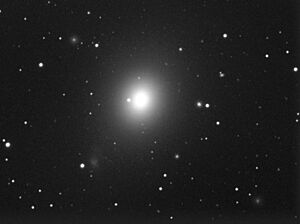Messier 49 facts for kids
Messier 49, also known as NGC 4472, is a giant galaxy shaped like a stretched-out ball. It is found in the constellation of Virgo. This amazing galaxy is about 49 million light-years away from Earth. A French astronomer named Charles Messier first discovered it in 1771. You can find Messier 49 near the star Epsilon Virginis in the sky.
Contents
What is the Virgo Cluster?
Messier 49 was the very first galaxy found in the huge Virgo Cluster. This cluster is a group of many galaxies held together by gravity. Messier 49 is the brightest galaxy in the entire Virgo Cluster. It shines more brightly than any other galaxy closer to our own planet. Messier 49 is also part of a smaller group within the cluster called the Virgo B subcluster. This galaxy is even pulling on a tiny, oddly shaped galaxy named UGC 7636.
What Special Features Does Messier 49 Have?
Messier 49 sends out normal radio waves, like many galaxies. However, the center of this galaxy also gives off X-rays. This is a big clue that there is a supermassive black hole at its heart. This black hole is incredibly huge, weighing about 565 million times the mass of our Sun.
The bright outline of Messier 49 stretches out very far from its center. It reaches a distance of about 260 thousand parsecs. A parsec is a unit of distance used in space, much larger than a light-year.
Supernova in Messier 49
Only one supernova has ever been seen in Messier 49. A supernova is a powerful and bright explosion of a star. This event, called SN 1969Q, was discovered in June 1969.
Globular Clusters
Messier 49 has a huge collection of star clusters, called globular clusters. Scientists believe there are about 5,900 of these clusters orbiting the galaxy. These clusters are very old, usually around 10 billion years old.
Between 2000 and 2009, scientists found strong evidence of a smaller black hole inside one of these globular clusters. Another possible black hole was announced in 2011.
See also
 In Spanish: Galaxia elíptica M49 para niños
In Spanish: Galaxia elíptica M49 para niños


